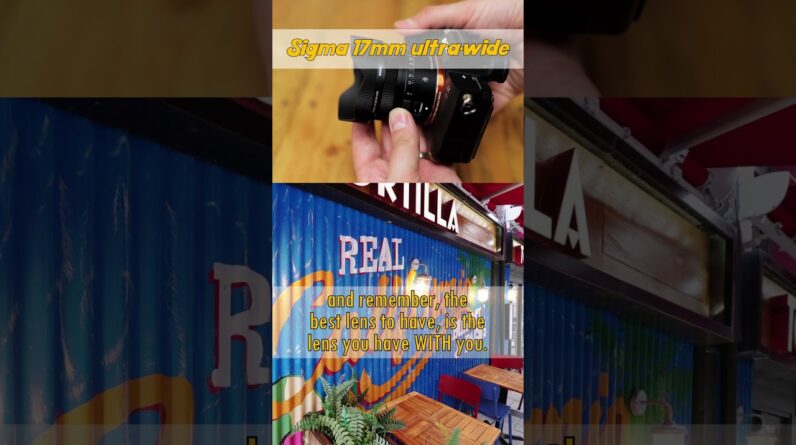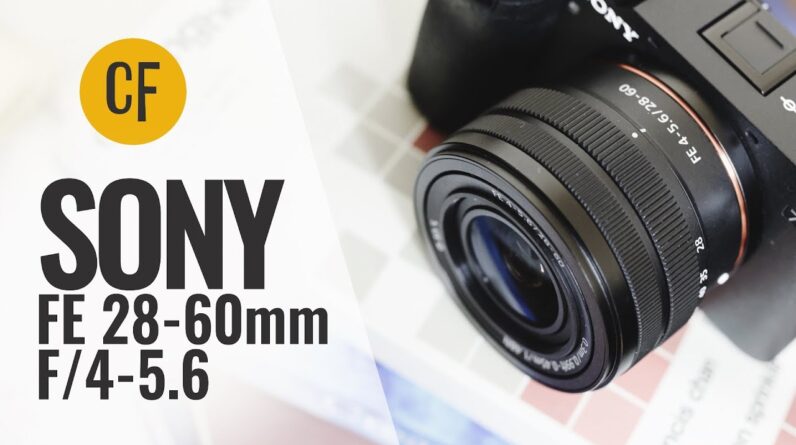Hi I'm Gordon from camera labs and in This video you're going to see an Exclusive teardown of a new Canon RF Lens and a peek into their latest Optical technology in manufacturing if You've ever been curious what goes on Inside a modern lens this is the video For you normally camera companies can be Quite secretive about their designs and In 30 years of technical journalism I've Rarely had any official access to the Actual manufacturing processes Beyond Occasional Factory visits with anxious Managers ensuring we don't look too Closely so when Canon reached out and Asked if I'd be interested in filming One of their Engineers disassemble a new Lens in close-up detail and explain Exactly what's behind their latest Optical designs I said yes please now This video isn't sponsored by Canon it's Just a rare opportunity to look behind The scenes which I thought would be Interesting to anyone who's into lenses Regardless of the system they use so Thanks to Canon for the invitation and Let's get started our specimen today is The Canon RF 28 mil F 2.8 STM a pancake Lens announced in May 23 which uses some Pretty interesting new types of optical Elements to achieve its compact size and Weight all lenses start with a design Breathe from setting out not just the Focal length and aperture but also the
Target quality the approximate size and Weight and of course the desired price Point for this model Canon wanted to Produce a compact and affordable pancake Lens for the ESR mirrorless system and 28 mil was chosen as it's a flexible Focal length for Stills photography and Video on both full-frame and cropped Aps-c systems trouble is though the Shorter back focus distance of Mueller's Cameras compared to dslrs presents an Optical challenge for wide-angle lenses If you don't do it right you'll suffer From greater softening and darkening Towards the corners the diagram on the Left shows the earlier EF 40 millimeter F 2.8 lens designed for the longer Flange distance of dslrs notice the Fairly shallow angle of the light Ray as It strikes the extremes of the sensor Now on the right look what happens if You try to use the same Optical formula For the shorter flange distance of a Mirrorless camera the angle of the light Ray becomes larger resulting in Greater Darkening and softness towards the Corners to reduce the angle at the Extremes you need a new Optical design With some unconventional looking Elements here's Canon's solution for the Rf-28 where a series of three large Aspherical elements towards the rear of The lens work together to deliver much Shallower light rate angles the largest
Element of all at the rear is only Possible thanks to the diameter of the RF Mount but proposing a design is only One half the story now you need to Actually make these unusual elements in Practice again while attempting to meet The target weight and price point the Rf-28 2.8 design employs three Aspherical elements so called as their Shape is not a section of a simple Sphere or cylinder modern lenses often Employ a spherical elements alongside More conventional spherical ones to Reduce issues like spherical aberrations But there's actually several ways to Make them Canon has four different ways Of producing a spherical elements Depending on the target quality weight Price and the actual complexity of the Shape itself a typical lens could Include elements made using several of The following techniques The first and most traditional option is To grind the shape Cannon typically Grows fluorite crystals then grinds them Into the desired shape which can produce Very high quality results but they're Also heavy and expensive to make so Generally reserved for their Flagship L Series lenses the second technique is Replica spherical where a normal Spherical element is bonded with a resin Layer to give it a spherical shape third And fourth use molding techniques to
Shape molten glass or plastic resin into The desired aspherical shape these allow Often complex shapes to be produced at a Low cost and thereby are a popular Option in consumer lenses again the Final lens design could include a Combination of elements made using these Different techniques in order to meet The target brief of the four techniques Plastic molded elements or pmos may seem Like a basic approach but by injecting Optical grade resin into a Precision Mold then hardening it with UV light You're able to easily make elements that Wouldn't be possible with glass molding Or prohibitively expensive with grinding Techniques indeed the rf-28 2.83 largest Spherical elements are all produced Using plastic molding and allow it to Not only meet the Target price weight And size but also deliver high quality Results than you might expect while pmos Are a fairly modern technique for Producing elements Canon's actually been Using them in many of its lenses for Some time now in fact most of the more Affordable lenses in the RF lineup Employ pmos and their Optical designs Including the 16 2.8 15 to 30 24 to 50 24 to 105 STM 24 to 240 24 1.8 51.8 and 100 to 400 as well as the RFS Lenses designed for cropped aps-c bodies Going further back still pmos were also Used in the EFM 18-55 18 to 150 and 15
To 45 as well as the EFS 18-55 and 18 to 135 so they've actually been been around For some time and most Canon owners have Probably had at least one in their Collections in fact pmo's first outing For Canon was in the snappy 50 back in 1982. the use of plastic molding also Allows you to easily produce squared off Rectangular shaped elements allowing Lens designers to not only reduce weight But reclaim space occupied by redundant Portions of a traditional circular Element remember your sensoring photos Are rectangular so technically there's No need for all the elements to be Circular of course you could also grind A glass or fluorite element into a Rectangle but it would add to the cost Versus a molded element where it's Produced at the time of injection so Let's now see how all this theory is put Into practice by disassembling the rf28 2.8 and seeing not just those unusually Shaped elements but how the space Saving's been put to use the lens was Taken apart by shinsuke Ito from Canon Who guided me through each step in Component the entire process took Roughly half an hour but five sped up Sections here okay so the first step is Removing the lens mount there's four Screws to remove after which you can Prize the metal Mount from the barrel Note the diameter of the RF Mount is
What allows those large rear Elements Which in turn provide greater Flexibility in Optical design After popping out the central battle Section you can remove the external Decorative ring now you can see the main Circuit board for the lens along with The ribbon cable leading to the 12 pins Which used for communication with the Camera body the RF Mount allows much Faster data Communications than the Older EF mount in turn enhancing things Like focusing aperture control and Stabilization not to mention supporting Additional controls you can also see the Shape the circuit boards is exploiting The space that's freed up by those Rectangular lens elements and as partly What's allowing a more compact lens Barrel after unscrewing and removing the Circuit board it's possible to unscrew The external Barrel due to the size of The lens this is a fairly short Cylindrical section but it's home to the Main switch allowing you to select Manual or autofocus or assign the Focusing ring to a custom control Next is to remove the STM focusing motor Itself a tiny component that again slips Into the space freed up by the Rectangular lens elements accommodating Focusing Motors is a key challenge for Lens designers so the chance to exploit Any spare space is welcome cannons used
A gear type stepping motor here for size Smooth operation and Fast Response next Shouldn't prizes off the ring printed With the lens name and specs as seen From the front And now for what shouldn't calls the Fixed Barrel which surrounds much of the Lens Group which has become Progressively exposed during the Physical disassembly the lens is then Turned round to remove the filter Barrel Held in place by three screws as its Name suggests this is used to mount Filters and as a side note it's Interesting how a modern mirrorless lens Designs the larger elements are now Often at the rear of the lens leaving a Relatively small one at the front and That's the opposite to many DSLR lenses That we're used to next the lens group Is removed from the focus barrel and the Shun turns this from the side you'll see The helical grooves used to shift the Required lenses while focusing now Finally we can take part the main lens Group starting with the protection glass Which represents group six next comes Group 5 which consists of a single large Plastic molded a spherical element and From the reflections you can see this is The one with the seagull profile and Again notice its rectangular shape An action removes the first of several Tiny collars these are adjusted on each
Lens to fine tune their performance at The factory and ensure the Optics are Perfectly lined up The first lens group can now be Separated to reveal the electromagnetic Diaphragm or EMD for short this is what Adjusts the lens aperture and while it's Operated electronically by the camera in Normal use it's possible to demonstrate The opening and closing mechanism with The right tool this Iris on RF lenses Can also be adjusted in very fine Increments to minimize visible steps and Exposure while filming video after Removing another adjustment collar the Section containing the second and third Optical groups can be separated and After peeling off a ring you can see the Third group and this consists of another Plastic molded aspherical element note How this one is circular this leaves one Final group and if you've been counting You'll know it's group four again Containing one plastic molded a Spherical element and Light Group 5 It's A larger more complex shape with squared Off Corners this leaves the guide Barrel As the last part of the disassembly Process let's now take a closer look at The elements laid out in group order Starting with the outermost Group which Consists of two glass elements next Here's group two which also contains two Glass elements now here's group three
Which consists of one element and it's The first of the three plastic molded or Pmo aspherical elements next in group 4 Is the set second pmo and notice how It's squared off and after that it's the Rear most fifth group containing another Single pmo that's also rectangular in Shape these five groups of seven Elements make up the main Optical Construction of the lens but there's an Additional covering element at the very Rear representing a sixth group let's Take a closer look at the three main Plastic molded aspherical elements and As soon angles them to catch the Light You'll notice the reflections revealing Their unusual shapes in particular the Two squared office spherical elements Employ almost wing-like profiles not Dissimilar to say a seagull and fly tour Perhaps an elaborate mustache I love Looking at Reflections in lenses and Some of these remind me of the black Hole in interstellar anyways these Shapes that are allowing compact wide Angle mirrorless lenses to deliver Well-corrected results into the corners Despite the short flange distance and I Believe Canon is one of the first Companies to produce this kind of Element for a mass-produced lens and While you could in theory grind them out Of fluoride or other elements it again Would be difficult expensive and in some
Cases completely impractical indeed Plastic molding was primarily chosen Here as the best way to achieve the Actual complex shape with the added Benefits of being lighter and more Affordable while also providing the Opportunity for squared off shapes Canon's also making bold claims about The performance with the rf-28 2.8 MTF Chart looking pretty respectable against The high-end rf2870 f2l Zoom at 28 mil Albeit open to F2 the rf28 2.8 MTF chart Also compares favorably against Nikon's Recent z26 2.8 and while the dimensions And weights are similar Canon's is also Coming in cheaper in my 30 years of Reviewing camera gear I've learned it's Important to approach new materials Technologies and techniques with an open Mind and the bottom line is while High-end lenses like Canon's L Series Will continue to grind fluorite elements For some time plastic molded elements Are allowing more more Compact and Affordable designs that literally punch Above their weight of course the proof Of the pudding is in the eating so I'll Be thoroughly testing the rf28 2.8 as Soon as I get hold of a reviewable Sample to see if it lives up to Expectations make sure you subscribed With notifications so you don't miss out On that or any of my other in-depth Reviews in the meantime I hope you
Enjoyed this technology backgrounder and Thanks again to Canon for the Opportunity to Peep Behind the Scenes of Their latest lens designs and of course Shun's expert skills at taking apart the Lens now all I have to do is figure out How it all fits back together again Thanks for watching and I'll see you Next time bye






